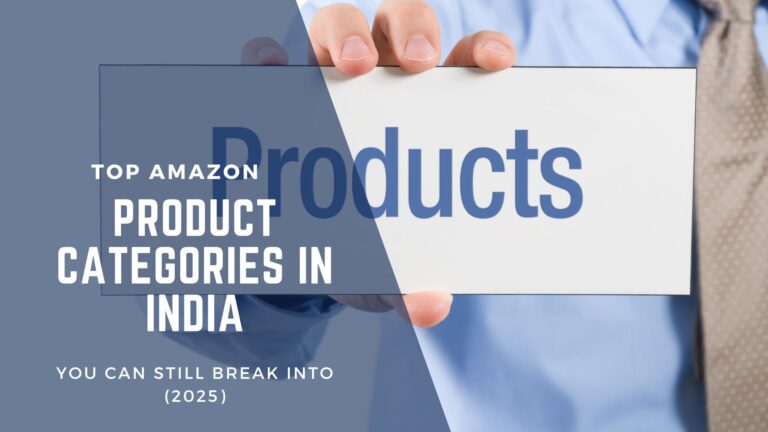Introduction: Why 2025 Still Offers Hidden Amazon Goldmines
If you think Amazon India is too crowded to start, think again. Despite the explosion of online sellers, the platform is still only scratching the surface of India’s potential. E-commerce penetration in India hovers below 10%, and millions of consumers from Tier-2 and Tier-3 cities are just beginning to explore shopping online. Amazon’s push into regional languages, improved logistics, and “Make in India” manufacturing support have created a fresh wave of opportunities for new sellers.
2025 is not about discovering something entirely new—it’s about finding something underserved. As consumer behaviors evolve, so do their needs. The rise in home organization, wellness awareness, sustainability, and regional pride has created gaps waiting to be filled. The challenge isn’t finding a product—it’s finding the right Amazon product category in India sellers can truly own.
Let’s explore the mindset, categories, and strategies to uncover these hidden goldmines.
Understanding the “Niche” Mindset for Amazon India
A niche isn’t just a product—it’s a focused market segment that solves a specific problem or fulfills an emotional need. For example, instead of selling “home decor,” a niche seller focuses on “eco-friendly bamboo storage boxes for small apartments.” It’s sharper, clearer, and easier to dominate.
Most new sellers fail because they copy what’s trending instead of what’s missing. When you enter a niche that’s already filled with look-alike listings, your only way to compete is by slashing prices—and that’s a race to the bottom. The real opportunity lies in discovering what people want but aren’t yet finding easily.
When you understand how to align emotional demand with product functionality—what people “want to feel” rather than just what they “want to buy”—you unlock the secret to profitable positioning. The best Amazon niche India sellers in 2025 are those who serve micro-communities with precision, passion, and clear differentiation.
What Makes a Break-In Product Category (vs. a Saturated One)
Not all product categories are equal. A “break-in” product category is one that still has consistent demand but limited competition. These product categories are usually early in their growth cycle, with decent margins, low fragility, and untapped creative potential.
You can spot such product categories by looking for:
- Products with under 200 reviews but steady sales.
- Gaps in listing quality—poor images, weak A+ content, missing videos.
- Frequent “wish it had this” comments in reviews.
On the other hand, saturated product categories show clear red flags: constant price wars, cloned listings, high return rates, and fragile shipping requirements. Categories like phone cases or resistance bands are classic examples—they’re everywhere, but almost no one’s making profit.
If you want to enter a growing market with real potential, your research should focus on Amazon product category in India that balance volume and differentiation.
Top 7 Amazon product categories in India to Watch in 2025
1. Home & Lifestyle product category
Home is where most online spending now happens. From storage hacks to aesthetic décor, consumers are turning to Amazon for convenience and inspiration. Products that make Indian homes more functional and beautiful—especially in compact urban apartments—are thriving.
Think space-saving furniture, modular organizers, and aesthetic kitchen tools. Products like under-sink storage units, bamboo cutlery trays, or wardrobe organizers are prime examples of “everyday innovation.” They’re not new categories—but they’re underserved, with room for better design, branding, and visuals.
Tip — Read How to Boost Your Amazon Listing for Greater Visibility and Sales
2. Health & Wellness product category
The wellness movement has permanently changed consumer behavior. Indians are investing more in joint supports, posture correctors, sleep aids, neck bands and air purifiers. Beyond physical health, mental wellness has opened sub-categories for journals, aroma diffusers, and stress-relief accessories.
The next growth wave lies in fusion product categories—where wellness meets beauty, such as collagen supplements, massage rollers, or herbal tonics. Indian suppliers make private labeling affordable, giving sellers a huge edge.
3. Sustainable & Eco-Friendly Products
Eco-conscious buying is no longer a fad—it’s becoming mainstream. From biodegradable trash bags to bamboo toothbrushes and refillable sprays, eco-friendly living is influencing urban consumer choices.
Brands emphasizing “plastic-free packaging” are growing twice as fast as their conventional counterparts. Even simple swaps—like coconut coir scrubbers or cotton tote bags—can position you as part of a sustainability-driven product category. With eco-awareness rising and costs dropping, this is one of the best Amazon product categories India 2025 has to offer.
4. Regional & Cultural product categories
India’s cultural diversity is a treasure chest for product sellers. Products inspired by regional crafts, local materials, or traditional practices are finding nationwide audiences thanks to Amazon’s logistics reach.
Imagine Tamil copper water bottles, Madhubani art décor, or handloom table mats reaching Delhi or Bangalore homes. “Make in India” grants and local manufacturing incentives make this product categories both profitable and patriotic. It also resonates emotionally with buyers seeking authenticity and heritage.
Explore How to Incorporate Sustainability Practices into Your Amazon Brand
6. Kids & Learning product categories
Parents everywhere want meaningful, screen-free learning tools. The pandemic made educational toys, flashcards, and activity kits household essentials. In 2025, this trend continues under a broader demand for Montessori and DIY kits.
It’s an evergreen product categories driven by emotion—parents buy these products out of care, not impulse. Combine that with the gifting market, and you’ve got a product that can sell year-round with minimal price sensitivity.
7. Digital & Work-from-Home Accessories
Hybrid work culture is here to stay, which means ergonomic and digital accessories remain in demand. Products like portable laptop stands, webcam covers, and desk cable organizers fit into impulse-buy price ranges but deliver daily utility.
The best part? Most of these products are lightweight, easy to ship, and cheap to manufacture locally. For sellers who want quick entry and scalable margins, digital and work-from-home gear is still a lucrative segment.
How to Find Untapped Amazon product categories Products in India
How to find untapped Amazon product categories in India? It starts by flipping your research process. Don’t search for “what’s selling”—start by identifying “what’s missing.”
- Find pain points first. Go through reviews in your target categories and note recurring complaints.
- Look for low-review products with solid sales ranks (BSR). That’s a sign of unmet demand.
- Validate with tools like Helium 10 Black Box by filtering for low-competition, moderate-volume listings.
Also see Unlocking the Power of Helium 10
Tools & Data Sources to Validate Your product categories
Many new sellers rely on gut feeling—but data should always lead the way. The best tools for product category validation in India is Helium 10.
Validation isn’t just about volume—it’s about sustainability. A product that’s trending today might vanish tomorrow. Look for steady, year-long graphs and keyword consistency before you commit. That’s how smart sellers uncover lasting Amazon product category opportunities India instead of one-hit wonders.
Are Private Label product categories Still Profitable in India (2025)?
Absolutely! Many new sellers wonder, “Are Amazon private label product categories profitable in India in 2025?” The short answer is yes—but only for those who adapt.
Private label profitability comes from building micro-brands with strong differentiation. With Indian suppliers now offering smaller MOQs and faster lead times, launching your own brand is easier than ever. You can test 100–200 units, run influencer campaigns, and scale what works.
Read How to Get Products Manufactured Under Your Brand Name for Amazon Sellers in India
Common Pitfalls to Avoid When Choosing product categories
Even the best ideas fail if the groundwork isn’t solid. The most common mistake sellers make is chasing global trends without considering Indian realities. What sells in the US might flop in India due to pricing, availability, or logistics.
Overlooking logistics costs—especially for bulky or fragile products—can destroy your profit margins. Another trap is blindly copying the top listings. When you blend in, you disappear. Instead, analyze top reviews for product pain points and differentiate your offer visually and functionally.
Remember: a product category doesn’t fail because it’s small. It fails because your product looks like everyone else’s.
Action Plan: Turning product category Research into a Real Product
Finding your product category is half the job. Turning it into a profitable business requires structured action:
- Start by shortlisting three promising product categories from your research.
- Validate each using data and community feedback—forums, Reddit, or Facebook groups.
- Choose one product category to test first with a small order of 100–200 units.
- Create premium listings with professional images, A+ content, and storytelling that highlights how your product solves real pain points.
- Run launch ads with a small budget and get your first 5–10 reviews from genuine customers.
Success doesn’t come from endless planning—it comes from fast validation. Start with one product category. Validate fast. Scale the winner.
FAQ: Amazon India product category Questions Answered
What are the best Amazon product categories for India in 2025?
Home & Lifestyle, Health & Wellness, Sustainable Products, Pet Care, Kids’ Learning, and Work-from-Home accessories.
Which product categories on Amazon India still have low competition?
Tier-2 city-focused products, eco-sustainable goods, and locally handcrafted items.
How to find untapped Amazon product categories in India?
Focus on problems first, read product reviews to spot recurring complaints, and use Helium 10 or Jungle Scout to confirm demand.
Are Amazon private label product categories profitable in India in 2025?
Yes—especially when sellers focus on micro-product categories, quality differentiation, and Indian supplier partnerships.
What tools can help identify product categories for Amazon India?
Helium 10 and Amazon Brand Analytics for data validation and keyword tracking.
Conclusion: The Window Is Still Open — If You Act Now
Amazon India is far from saturated. The platform’s growth in 2025 continues to open new lanes for innovative, quality-driven sellers. The difference between early and late movers isn’t timing—it’s courage.
Don’t wait for the perfect idea. Begin where data, passion, and opportunity intersect. Test, learn, and iterate faster than others. Each month you delay is a month someone else captures your future customers.
If you’re ready to take the first step, Join our 3 Day Live Workshop to learn how to proceed step by step.
The best time to start was yesterday. The second-best time is now.










